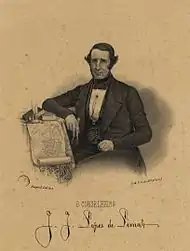Xenddi
Xenddi, sometimes spelled as Xendi,[1] was a discriminatory religious tax imposed on Hindus by the colonial era Portuguese Christian government in 17th-century Goa.[2] It was similar to the discriminatory Jizya religious tax imposed on Hindus by Muslim rulers in the region.[2]

The term Xenddi also spelled Xendim or Xendy meant "hair tuft", a slang for the top-knot hair style of Hindus, likely derived from the Marathi word Sendi or Shendi.[3][4] The discriminatory Xenddi tax on the Hindu artisans and merchants was higher than on the Hindu peasants in Portuguese colonies in India.[5] The Xenddi tax was not payable by those who converted from Hinduism to Christianity.[3]
In its initial formulation, the tax was introduced with the pretext that Hindus did not own any land in Goa and only the Christians did. Land revenues were paid by the Portuguese Christians in Goa, and the regional Church argued that Xenddi tax would make Hindus pay their fair share. The tax and the tax rate on Hindus evolved to be an abusive form of religious discrimination.[6][7] According to Rene Berendse, the Xenddi tax was considered to be an example of religious intolerance by the neighboring Maratha Empire, and its local leader Govind Das Pant made abolishment of the discriminatory tax against the Hindus as a condition for a mutual armistice agreement.[6] The Goan government initially refused, stating that the Xenddi tax was a matter of the Church, which the Portuguese state cannot interfere in.[6] Expanded to all of Portuguese colonies in the Indian subcontinent by 1705, the Xenddi tax was abolished in 1840, with J.J. Lopes de Lima – the Governor General of Goa declaring it to be "cruel, hateful tribute and ridiculous capitation tax" on the Hindus.[7]
The tax was initially imposed only on Hindus, but in later stages expanded on Indian Muslims in Goa. The tax was oppressive and arbitrary, its collection based on severe extortions and abuses, according to Teotonio R. De Souza.[8] The discriminatory taxes were one of the many religiously targeted practices of the Portuguese clergy, states Aniruddha Ray, along with the prohibition on Hindus in Goa from observing their religious festivals. This led to widespread emigration of Hindus out of Goa and in other cases to conversion.[9]
References
- Rene J. Barendse (2009). Arabian Seas, 1700 - 1763. BRILL Academic. pp. 697–698. ISBN 90-04-17658-6.
- Teotonio R. De Souza (1994). Discoveries, Missionary Expansion, and Asian Cultures. Concept. pp. 93–95. ISBN 978-81-7022-497-6.
- Délio de Mendonça (2002). Conversions and Citizenry: Goa Under Portugal, 1510-1610. Concept Publishing. pp. xvi, 116–117. ISBN 978-81-7022-960-5.
- Pierre du Jarric Jarric (2004). Akbar and the Jesuits: An Account of the Jesuit Missions to the Court of Akbar. Routledge. pp. 135 note 3. ISBN 1-134-28507-8.
- Teotonio R. De Souza (1990). Goa Through the Ages: An economic history. Concept Publishing. pp. 89–90. ISBN 978-81-7022-259-0.
- Rene J. Barendse (2009). Arabian Seas, 1700 - 1763. BRILL Academic. pp. 435–436 with footnotes. ISBN 90-04-17658-6.
- Teotonio R. De Souza (1994). Goa to Me. Concept. pp. 112–113. ISBN 978-81-7022-504-1.
- Teotonio R. De Souza (1994). Goa to Me. Concept. pp. 110–113. ISBN 978-81-7022-504-1.
- Aniruddha Ray (2016). Towns and Cities of Medieval India: A Brief Survey. Taylor & Francis. pp. 151–152. ISBN 978-1-351-99730-0.